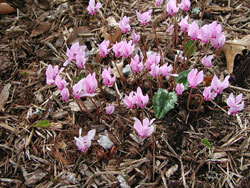Resource Library
Plant of the Week: Hardy Cyclamen
The University of Arkansas System Division of Agriculture does not promote, support or recommend plants featured in "Plant of the Week." Please consult your local Extension office for plants suitable for your region.
Plant of the Week
[A-Z]
Hardy Cyclamen
Latin: (Cyclamen hederifolium)

In gardening, bigger is not always better. Many gardeners prefer small, delicate-looking plants instead of the super-sized, and often gaudy, flowers of the florist. The hardy cyclamen are a good example of plants having lots of appeal in a small package.
About 20 species of cyclamen have been described with all native to areas surrounding the Mediterranean basin and parts of central Asia. Cyclamens belong to the primrose family. Most familiar amongst them is Cyclamen persicum, the florist cyclamen, which makes a splendid cool season flowering pot plant but is frost tender and dies with the first freeze. The more winter hardy forms come from higher up in the mountains of the region and have more winter hardiness than their delicate looks would indicate.
Two hardy cyclamen species are commonly offered in the horticultural trade; the late summer and fall flowering C. hederifolium (incorrectly sold as C. neapolitanum) and the early spring flowering C. coum. Both are small plants growing four to six inches tall when the pink, inch-long flowers are produced singly at the end of the sturdy stem. The back-swept and twisted petals are united on a downward facing ring and give the impression of a butterfly at rest.
While flowers are the main feature, cyclamen foliage is equally showy. Leaves are heart-shaped in outline and marked by contrasting bands of green, gray and silver. Every leaf is marked differently. The foliage appears in the fall and persists until late spring when plants go dormant for the summer. Fall flowering species usually bloom without leaves while spring blooming kinds have flowers present when they bloom.
Cyclamen form a flattened tuber that can reach several inches across in a few years; in decades they can become saucer sized. These form just under the soil surface and produce roots from the top of the tuber. When planting the tubers, the concave side goes up. Young tubers produce a few flowers scattered over a few months; old, large tubers can produce up to 500 blooms.
Regardless of their delicate looks, hardy cyclamen are easy to grow. C. hederifolium is considered the easiest and most hardy, surviving as far north as zone 4 and as far south as zone 9. All hardy cyclamen do best in a highly organic but well-drained soil where they can be kept dry during the summer. They grow best in bright areas with some shade. Because the tubers can rot if kept too wet they are well suited for growing in the root zone of shade trees.
Tubers are best planted as early as possible in the late summer or fall. Work peat moss or leaf compost into the soil and plant so that the tuber is just barely covered. Adding some limestone chips to improve drainage and raise the soil pH above 6.0 is also a good idea.
Plant cyclamen tubers 6 to 10 inches apart in an area that will not be disturbed or overgrown by more vigorous neighbors. They are good companion plants with trilliums and other small, delicate woodland plants. Hardy cyclamen persist for generations, but it can take up to a decade for tubers to put on a really good display. Patience is the cyclamen growers’ best virtue; sometimes plants will lie dormant for a year before showing signs of life. When plants go dormant in the summer mulch over the area with a light layer of leaf mold.
By: Gerald Klingaman, retired
Extension Horticulturist - Ornamentals
Extension News - October 17, 2008
The University of Arkansas System Division of Agriculture does not maintain lists of retail outlets where these plants can be purchased. Please check your local nursery or other retail outlets to ask about the availability of these plants for your growing area.